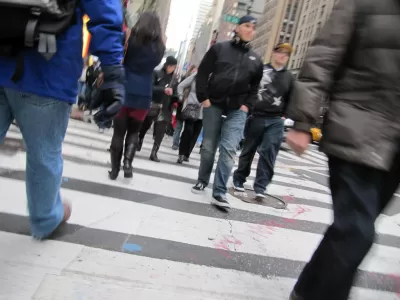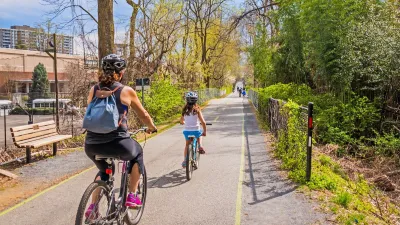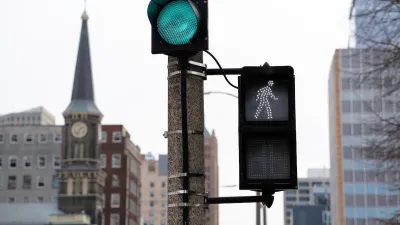As cities such as New York recognize the need to stop treating pedestrians as second-class citizens, the Pedestrian/Traffic Manager (PTM) has emerged as a new tool in the effort to improve the mobility and safety of those on foot.

Throughout North America, cities are recognizing the need to stop treating pedestrians as second-class citizens. For the first time since auto-centric planning began to take hold several decades ago, the mobility and safety of pedestrians is being given as much attention as motorized vehicles, as the movement to create livable streets gains momentum.
New York City is a prime example of how the pedestrian has begun to triumph over the motor vehicle. It was just a short time ago, in places like Times Square and Herald Square where pedestrians were forced to squeeze into narrow sidewalk space, often spilling into the streets to battle it out with oncoming cars and buses. This practice has thankfully been replaced with bike lanes and pedestrian plazas which have improved the quality of life and safety for residents and visitors to the area. Along with the increase in pedestrian space, a new tool has emerged to help increase pedestrian safety: the Pedestrian/Traffic Manager—an individual trained and certified exclusively in the movement and safety of pedestrians in high density areas.

The concept of the Pedestrian/Traffic Manager (PTM) is an innovation that has taken hold in New York City. He or she is a cross between a traffic enforcement agent and a crossing guard. In New York, they are certified to work on the streets in construction zones, and have been adopted into the New York City Rules and Regulations. The PTM is required to undergo a certified training course and many have some type of law enforcement background.
The PTM is a special breed; along with training in traffic management, they are required to be trained in customer service and dealing with the public—a monumental task when dealing with busy crowds in a city whose population is consistently late for one reason or another, and tempted to jaywalk at the smallest gap in oncoming traffic. The PTM is not authorized to write a summons and the only badge of visual authority is his/her yellow reflective vest (with a Pedestrian Safety logo on the back), a whistle and maybe, a plastic lighted baton.

The idea of the PTM originally took hold during the reconstruction of the World Trade Center site, where an unprecedented amount of construction was underway in an area still teaming with tourists, residents and businesses. During this time, it became increasingly clear that the growing number of pedestrians in the area were in need of a safety advocate; someone who could guide them through this massive new construction zone with the sole purpose of their safety in mind, not that of the vehicle.
In need of a solution, the Port Authority of New York and New Jersey reached out to the private sector. They hired a private engineering firm which established a newly minted team of former law enforcement officials trained in pedestrian management to run this new operation. The idea quickly spread to other areas of the city with acute pedestrian-vehicle conflicts. Currently they can be found in areas that include construction sites, shopping malls, entertainment arenas, Times Square, and Business Improvement Districts.
PTM’s are employed and deployed by both the public and private sectors. The New York City Department of Transportation deploys their own version of the PTM called the “Street Safety Manager” which focuses as much on bicycle safety as it does on pedestrian safety. Some private firms maintain their own teams of trained and certified PTM’s which can hired by construction companies when city specifications require them, as well as other organizations such as those mentioned above.
The benefits to the areas in which PTM’s have been deployed have been significant. A recent study conducted in the area of Hudson Square (a direct conduit to a high volume vehicular tunnel which cuts through a residential area) shows remarkable results. Along with crossing thousands of pedestrians safely each day, the PTM’s have improved the quality of life in the area by keeping the intersections clear of vehicles; thus reducing vehicle emissions and horn-honking. On a typical day, data collected by Sam Schwartz Engineering, PLLC shows that blocked crosswalks have decreased by an average of 43%, blocked intersections have decreased by an average of 61%, and the number of honks has decreased by an average of 53%.
The table below shows the results of another study. In this case, pedestrian non-compliance at “walk,” “don’t walk” lights were observed at Times Square with and without PTM’s. As can be seen, without the Pedestrian Managers, the non-compliance to the crosswalk signal was 42.5%. With the Pedestrian Manager, the non-compliance rate dropped to 6.6%.

Another example of the success of the PTM can be seen in the Battery Park City area of New York City. The number of vehicles entering lower Manhattan has risen over recent years. According to the New York City Dept. of Transportation, there was a 6.9% increase in vehicles entering lower Manhattan through the Brooklyn Battery tunnel from 2009 to 2010. The number of pedestrians in this area has risen as well, due to the increase in tourism from the World Trade Center memorial and a residential building boom. PTM’s have been working this area at five separate intersections since 2010. Data was collected at these intersections and, on average, there has been an 11% growth in the number of pedestrians during the peak periods between 2010 and 2011. Since the implementation of the program, the PTM’s have crossed approximately 11 million pedestrians safely and securely.
After pouring ever more resources into the movement of vehicular traffic, the time has come for cities to focus of the movement and safety of pedestrians. The shrinking sidewalk has become a thing of the past. Iconic places like Herald Square have been remade as open, pedestrian plazas with comfortable seating for socializing and enjoying the scenery. It was only a short while ago that street furniture was the scourge of the shop-owner for fear of the “undesirable” taking residence upon a stray bench or fixture and the “Viewing Garden” was seen as a way to increase park space without allowing tactile interaction by the public. Thankfully, cities now recognize open plazas and pedestrian-ways as a positive, quality of life advancement for their neighborhoods. We have all come to realize that the happier and safer the public feels, the more they will visit, shop and work in an area.


Sheridan Square Viewing Garden Herald Square Pedestrian Plaza
The Pedestrian/Traffic Manager complements the new pedestrian-friendly mindset of popular urban areas. A yellow vest, whistle and a friendly face can go a long way to encourage safe pedestrian behavior, but perhaps it is really the will of the public that is prevailing. They will adhere to the red light and the whistle because they know they are winning the battle and, little by little, gaining equal ownership over the streets. They can walk with impunity, no longer the underdog in a world of honking horns and exhaust pipes. They finally have their advocate—the friendly face with the whistle, and reflective yellow vest and that special logo which reads “Pedestrian Safety.”
Ileanna Pappas is a Senior Manager at Sam Schwartz Engineering, DPC. She was formerly the Deputy Assistant Commissioner of Planning at the New York City Department of Transportation and received her BA and MA from Columbia University in Economic Geography.
Janet Campbell is a General Manager at Sam Schwartz Engineering, DPC. She was formerly Deputy Assistant Commissioner of NYCDOT Bridge preventative maintenance. She received her BA and MS from New York Polytechnic in Transportation Planning and Engineering.

Manufactured Crisis: Losing the Nation’s Largest Source of Unsubsidized Affordable Housing
Manufactured housing communities have long been an affordable housing option for millions of people living in the U.S., but that affordability is disappearing rapidly. How did we get here?

Americans May Be Stuck — But Why?
Americans are moving a lot less than they once did, and that is a problem. While Yoni Applebaum, in his highly-publicized article Stuck, gets the reasons badly wrong, it's still important to ask: why are we moving so much less than before?

Using Old Oil and Gas Wells for Green Energy Storage
Penn State researchers have found that repurposing abandoned oil and gas wells for geothermal-assisted compressed-air energy storage can boost efficiency, reduce environmental risks, and support clean energy and job transitions.

HHS Staff Cuts Gut Energy Assistance Program
The full staff of a federal program that distributes heating and cooling assistance for low-income families was laid off, jeopardizing the program’s operations.

San Antonio Remains Affordable as City Grows
The city’s active efforts to keep housing costs down through housing reforms and coordinated efforts among city agencies and developers have kept it one of the most affordable in the nation despite its rapid population growth.

What Forest Service Cuts Mean for Cities
U.S. Forest Service employees work on projects that have impacts far beyond remote, rural wilderness areas.
Urban Design for Planners 1: Software Tools
This six-course series explores essential urban design concepts using open source software and equips planners with the tools they need to participate fully in the urban design process.
Planning for Universal Design
Learn the tools for implementing Universal Design in planning regulations.
Heyer Gruel & Associates PA
City of Moreno Valley
Institute for Housing and Urban Development Studies (IHS)
City of Grandview
Harvard GSD Executive Education
Salt Lake City
NYU Wagner Graduate School of Public Service
City of Cambridge, Maryland




























